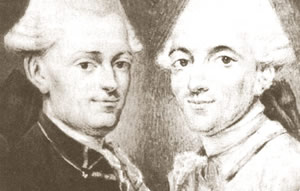Science of Conflict
The beginning of the airforce
The Montgolfier brothers, pictured on the right, are credited with inventing the first genuine method of sustained flight in a lighter-than-air craft. They were not scientists but business men involved with paper manufacture.
On 19 September 1783 at the Palace of Versailles the Montgolfiers launched their balloon which travelled two kilometres and reached a height of almost two kilometres. It is surprising to note that the two brothers had no idea how their balloon lifted off the ground. They had the false impression that the hot smoke that filled the balloon also propelled it upwards.

What propelled the balloon skyward was the principle of buoyancy. The same principle that enables submarines and ships to float in the water.
The air inside the balloon is heated and so it expands. As its volume of the hot gas expands it becomes less dense that the cold air around the balloon. The result is that the less dense, hot air inside the balloon will float or rise in the more dense, cold air surrounding it. When the air inside the balloon cools down then it will descend.
Buoyancy and density go hand in hand. A buoyant force is exerted on an object when placed in a medium that is less dense. Air bubbles are less dense than water so they quickly get pushed to the surface by the buoyant force exerted by the water. This buoyant force is equal to the weight of the water pushed aside (displaced) by the air bubble. The hot air balloon must push aside a mass of air greater than its own mass in order for it to lift off the ground. The size of the buoyant force is determined by the difference between the weight of the balloon and the weight of air been displaced by the balloon.

Jacques Alexandre Charles, pictured on the right, was a famous scientists who created Charle's law of gases. He made ballooning a science and experimented with different designs and gases.
Soon the balloon became a fashionable item as a sport, recreation and most importantly a tool for the military.
